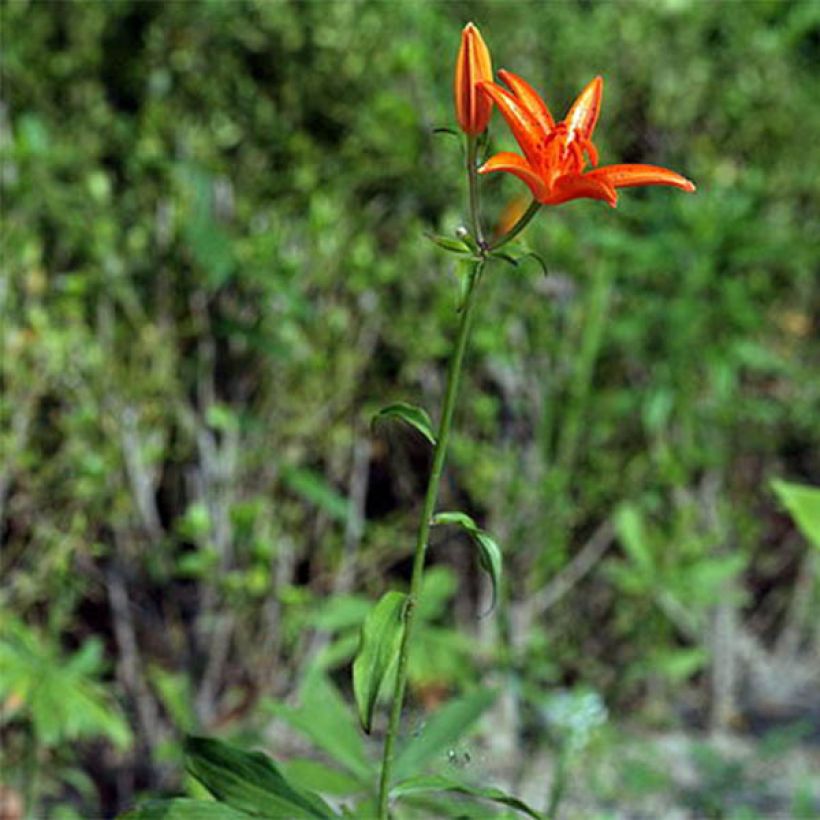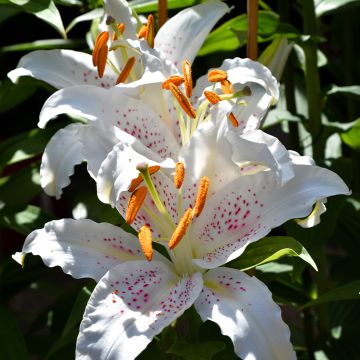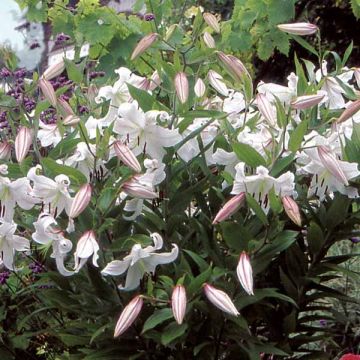

lis tsingtauense - Lilium
Lilium tsingtauense - Lily
Lilium tsingtauense
Twilight Lily, Chinese Trumpet Lily
Special offer!
Receive a €20 voucher for any order over €90 (excluding delivery costs, credit notes, and plastic-free options)!
1- Add your favorite plants to your cart.
2- Once you have reached €90, confirm your order (you can even choose the delivery date!).
3- As soon as your order is shipped, you will receive an email containing your voucher code, valid for 3 months (90 days).
Your voucher is unique and can only be used once, for any order with a minimum value of €20, excluding delivery costs.
Can be combined with other current offers, non-divisible and non-refundable.
Why not try an alternative variety in stock?
View all →This plant carries a 6 months recovery warranty
More information
We guarantee the quality of our plants for a full growing cycle, and will replace at our expense any plant that fails to recover under normal climatic and planting conditions.
Would this plant suit my garden?
Set up your Plantfit profile →
Description
Lilium tsingtauense is a rare Chinese botanical lily, related to the martagon lily, with numerous trumpet-shaped flowers, ranging from bright orange to red, spotted and speckled with brown. Its foliage is marbled with different shades of green, and its light fragrance is not always perceived as pleasant. This must-have variety for collectors is easy to grow in moist soil and partial shade.
Lilium tsingtauense is a deciduous bulbous plant, with a narrow and upright clump of foliage from spring. It belongs to the lily family. It is an Asian species, native to China and Korea, with slight variations depending on the origin. This compact plant will reach 80 cm (32in) high when in bloom, and the clump will spread indefinitely over time as the bulbs produce bulblets through vegetative multiplication. From the height of summer until September, medium-sized flowers, 8 cm (3in) in diameter, with shallow cups, appear in clusters of 6 to 15. They open towards the sky, carried by twisted pedicels. Their petals are very bright orange with brown spots. The dark green leaves are marbled with lighter green and are lanceolate, but wider towards their tips, arranged in whorls of 2.
This lily establishes itself a bit more slowly than Asiatic, trumpet, or Oriental lilies. It may take an extra season before flowering, and planting conditions must be carefully attended to. Martagon lilies and their relatives sulk when moved and need time to settle. Grow your lilies with other perennials in borders, as they like having their feet in the shade, and these other plants will help prevent the stems from bending in the wind. The tsingtauense lily likes moisture and filtered light. It is ideal in lightly shaded woodland areas, moist rockeries, and will be good for cut flowers. The botanical martagon lily is a close relative of this species and easily hybridizes with it. Like the martagon lily, Lilium tsingtauense is a protected bulb in the wild, with remarkable flowers and foliage.
Lilium tsingtauense - Lily in pictures




Plant habit
Flowering
Foliage
Botanical data
Lilium
tsingtauense
Liliaceae
Twilight Lily, Chinese Trumpet Lily
Cultivar or hybrid
Other Lilies
View all →Planting and care
Lilium tsingtauense, like the martagon lily, establishes itself a little more slowly than Asiatic, trumpet, or Oriental lilies. Good drainage and moist, fertile soil are essential. It is a good idea to add leaf compost and well-rotted compost in autumn. Plant the bulbs in a partially shaded area, preferably in spring, 15 cm (6in) deep in a mixture of soil, leaf compost, and gravel. Surround them with a layer of sand to prevent rot and slug attacks while allowing them to grow more easily. Mark the planting location as the vegetation only starts in April. If red lily beetles appear, treat them immediately as their larvae can devour all the leaves. The most effective method is to catch them manually but be careful as they drop as soon as touched. After flowering, it is a good idea to cut the faded flowers halfway to keep the bed beautiful for the rest of the summer.
Planting period
Intended location
Care
Planting & care advice
This item has not been reviewed yet - be the first to leave a review about it.
Haven't found what you were looking for?
Hardiness is the lowest winter temperature a plant can endure without suffering serious damage or even dying. However, hardiness is affected by location (a sheltered area, such as a patio), protection (winter cover) and soil type (hardiness is improved by well-drained soil).

Photo Sharing Terms & Conditions
In order to encourage gardeners to interact and share their experiences, Promesse de fleurs offers various media enabling content to be uploaded onto its Site - in particular via the ‘Photo sharing’ module.
The User agrees to refrain from:
- Posting any content that is illegal, prejudicial, insulting, racist, inciteful to hatred, revisionist, contrary to public decency, that infringes on privacy or on the privacy rights of third parties, in particular the publicity rights of persons and goods, intellectual property rights, or the right to privacy.
- Submitting content on behalf of a third party;
- Impersonate the identity of a third party and/or publish any personal information about a third party;
In general, the User undertakes to refrain from any unethical behaviour.
All Content (in particular text, comments, files, images, photos, videos, creative works, etc.), which may be subject to property or intellectual property rights, image or other private rights, shall remain the property of the User, subject to the limited rights granted by the terms of the licence granted by Promesse de fleurs as stated below. Users are at liberty to publish or not to publish such Content on the Site, notably via the ‘Photo Sharing’ facility, and accept that this Content shall be made public and freely accessible, notably on the Internet.
Users further acknowledge, undertake to have ,and guarantee that they hold all necessary rights and permissions to publish such material on the Site, in particular with regard to the legislation in force pertaining to any privacy, property, intellectual property, image, or contractual rights, or rights of any other nature. By publishing such Content on the Site, Users acknowledge accepting full liability as publishers of the Content within the meaning of the law, and grant Promesse de fleurs, free of charge, an inclusive, worldwide licence for the said Content for the entire duration of its publication, including all reproduction, representation, up/downloading, displaying, performing, transmission, and storage rights.
Users also grant permission for their name to be linked to the Content and accept that this link may not always be made available.
By engaging in posting material, Users consent to their Content becoming automatically accessible on the Internet, in particular on other sites and/or blogs and/or web pages of the Promesse de fleurs site, including in particular social pages and the Promesse de fleurs catalogue.
Users may secure the removal of entrusted content free of charge by issuing a simple request via our contact form.
The flowering period indicated on our website applies to countries and regions located in USDA zone 8 (France, the United Kingdom, Ireland, the Netherlands, etc.)
It will vary according to where you live:
- In zones 9 to 10 (Italy, Spain, Greece, etc.), flowering will occur about 2 to 4 weeks earlier.
- In zones 6 to 7 (Germany, Poland, Slovenia, and lower mountainous regions), flowering will be delayed by 2 to 3 weeks.
- In zone 5 (Central Europe, Scandinavia), blooming will be delayed by 3 to 5 weeks.
In temperate climates, pruning of spring-flowering shrubs (forsythia, spireas, etc.) should be done just after flowering.
Pruning of summer-flowering shrubs (Indian Lilac, Perovskia, etc.) can be done in winter or spring.
In cold regions as well as with frost-sensitive plants, avoid pruning too early when severe frosts may still occur.
The planting period indicated on our website applies to countries and regions located in USDA zone 8 (France, United Kingdom, Ireland, Netherlands).
It will vary according to where you live:
- In Mediterranean zones (Marseille, Madrid, Milan, etc.), autumn and winter are the best planting periods.
- In continental zones (Strasbourg, Munich, Vienna, etc.), delay planting by 2 to 3 weeks in spring and bring it forward by 2 to 4 weeks in autumn.
- In mountainous regions (the Alps, Pyrenees, Carpathians, etc.), it is best to plant in late spring (May-June) or late summer (August-September).
The harvesting period indicated on our website applies to countries and regions in USDA zone 8 (France, England, Ireland, the Netherlands).
In colder areas (Scandinavia, Poland, Austria...) fruit and vegetable harvests are likely to be delayed by 3-4 weeks.
In warmer areas (Italy, Spain, Greece, etc.), harvesting will probably take place earlier, depending on weather conditions.
The sowing periods indicated on our website apply to countries and regions within USDA Zone 8 (France, UK, Ireland, Netherlands).
In colder areas (Scandinavia, Poland, Austria...), delay any outdoor sowing by 3-4 weeks, or sow under glass.
In warmer climes (Italy, Spain, Greece, etc.), bring outdoor sowing forward by a few weeks.





















































